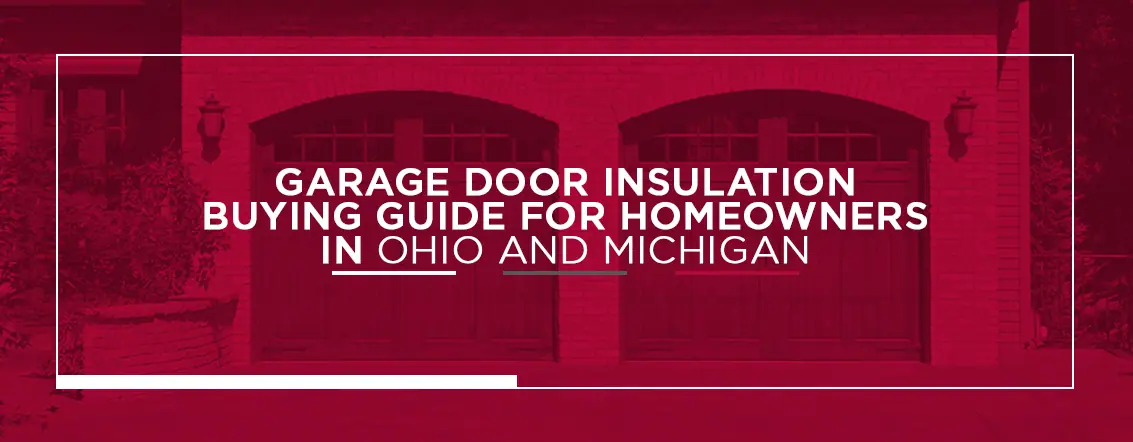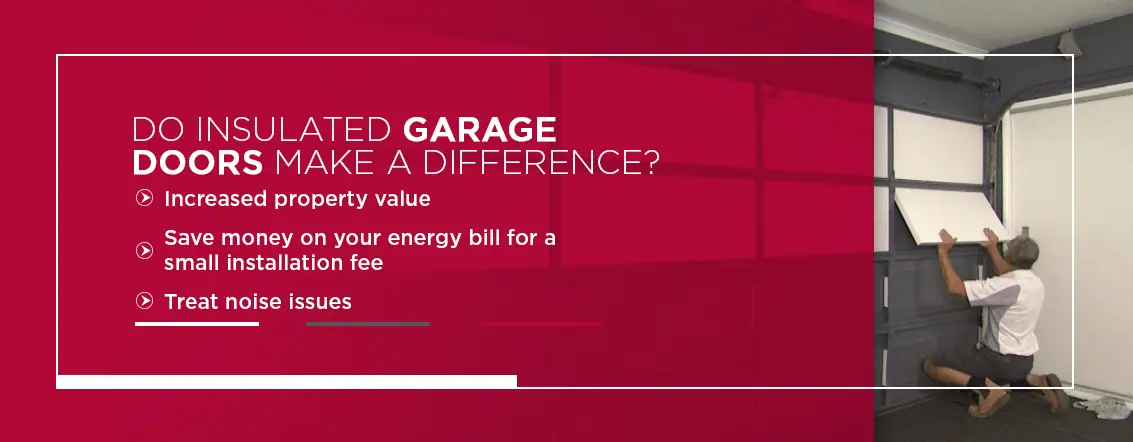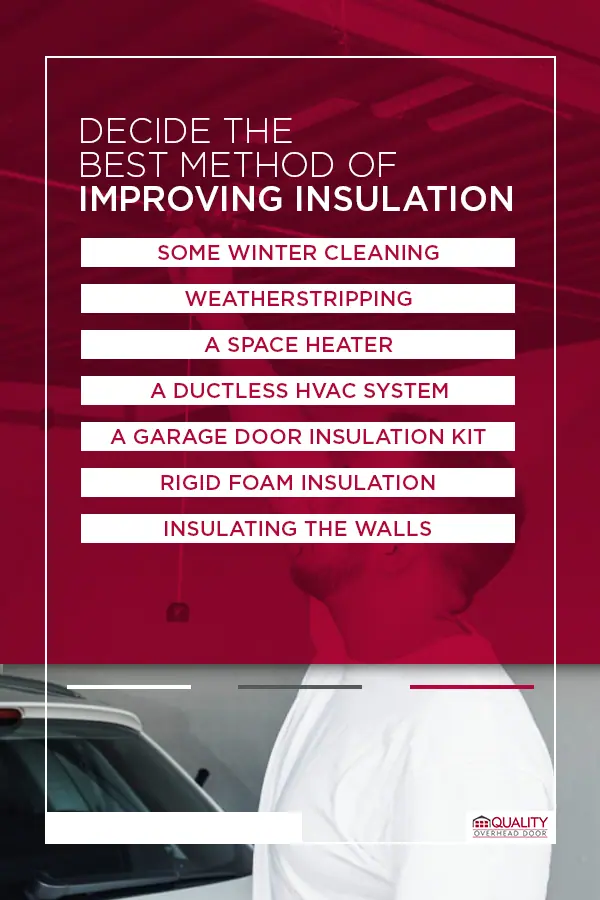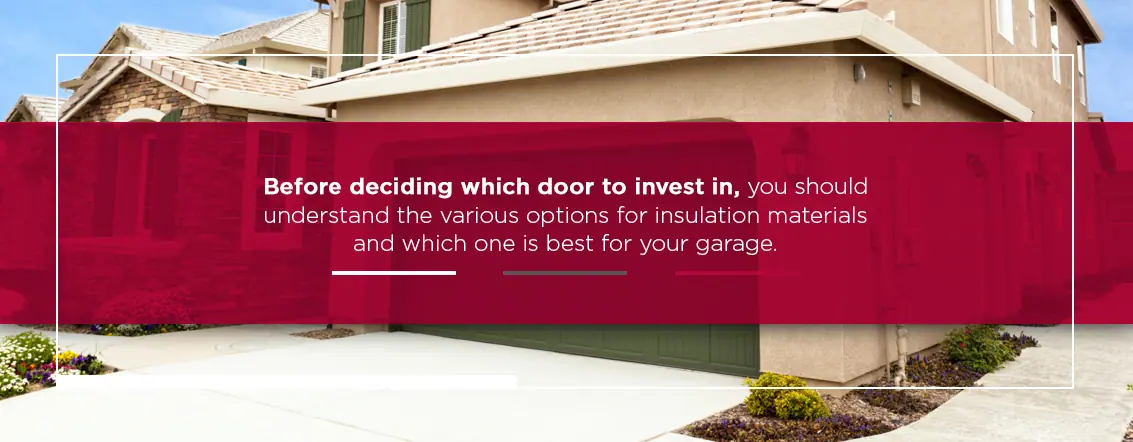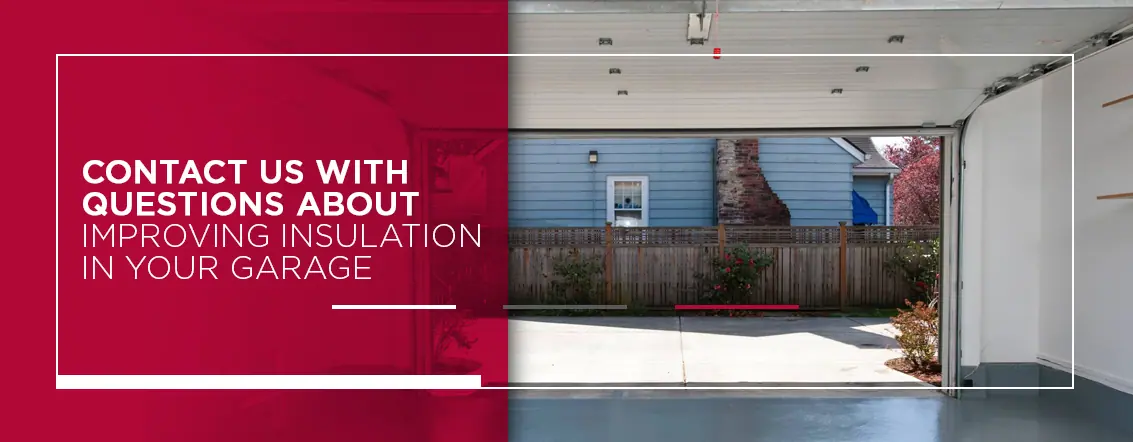If you live in northeast Ohio or southeast Michigan, you know winters can be chilly in your neck of the woods. As the cold winter approaches, you need to properly insulate your garage to lower your energy costs and protect your precious valuables. The best way to guard your garage from extreme temperatures is to insulate your garage door.
An insulated garage door can help regulate the temperature in your garage throughout the year. While you can improve insulation by sealing cracks and insulating the walls of your garage, you need an insulated garage door to complete the package. Use this guide to determine the best garage door insulation for your home.
The Importance of Garage Door Insulation
Instead of shivering in the cold as you walk from your car in the garage to the inside of your home, insulating your garage door can conserve a comfortable temperature. Insulation can also protect your garage contents and reduce energy costs.
- Safeguard the contents of your garage: You may leave your garage door open if it gets too hot in the summer. If you do so, you’ll tempt thieves to break in and steal your car or other valued possessions. An insulated garage door will let you leave your door closed all year long. Your garage door also protects the contents in your garage from extreme temperatures. Cold weather can affect your car’s functionality, including tire pressure, battery life and paint job. Rest assured that your car will work on a cold winter’s morning by insulating your garage door.
- Cut energy costs: You might use your garage as a primary point of entry into your home, so any air drafts in your garage can travel into the main part of the house. An insulated garage door can provide your home with warmth and comfort. The garage is one of the least energy-efficient areas of the home because of its air leaks and gaps. As a result, your HVAC system will have to work harder to create a comfortable airflow in your home. By installing an insulated garage door, you can improve the energy efficiency of your garage and slash your energy bills.
Do Insulated Garage Doors Make a Difference?
When you combine weatherstripping and insulating other areas of the garage, insulated garage doors can dramatically improve the energy efficiency of your home. By adding insulation to your garage door, you can increase the temperature in your garage by 10 to 12 degrees in the winter. You can buy a garage door insulation kit, or you can replace your garage door entirely.
Here are some of the ways insulated garage doors make a difference for your property.
- Increased property value: Insulated garage doors do more than boost the energy efficiency of your home. A new garage door can also improve your house’s property value. The 2019 Cost vs. Value Report from Remodeling revealed that in the East North Central region of the United States, a garage door replacement yields a 95.2% return on investment, making a garage door placement the most cost-effective way to increase the value of your property.
- Save money on your energy bill for a small installation fee: Insulating your garage door is one of the most economical ways to heat a garage. During the wintertime, when we can experience freezing temperatures, you’ll improve the functionality of your heating system by installing better garage insulation. On average, adding insulation throughout your home in the East North Central region of the United States will save you approximately 12% in total energy costs. Your garage door’s installation costs will pay for themselves in the amount of money you’ll save on your energy bill.
- Treat noise issues: An insulated door is usually much quieter than one without insulation. For most older doors without insulation, the track system can make a whiny grinding noise as the door moves. The insulation inside a newer garage door dampens the vibration of the door. It can also keep out sounds from outside your home.
With an insulated garage door, you will save money in energy bills, while protecting your valued possessions. Your car, tools and appliances will work more efficiently in a garage with adequate insulation. If you use your garage for extra work or living space, you should insulate your garage door to provide a warm and comfortable atmosphere for this part of your house.
How to Improve Garage Insulation
While insulating your garage door will improve the internal temperature, you should also insulate the rest of your garage to create the optimal temperature for your living space. To improve the insulation of your garage, you need to know where you’re losing heat and understand R-value.
Know Where You’re Losing Heat
Before you begin winterizing your living space, you should inspect your garage to find out where you’re losing heat. Any gaps or cracks could leak air into your garage and affect your home’s temperature. Here are some areas where warm air could be sneaking out of your garage.
- Walls: If you’re going to insulate your garage door, you should make sure your walls have enough insulation as well. Insulation will prevent heat from transferring through the walls and out of the home.
- Ceilings: Garages often have unfinished ceilings, designed with overhead rafters. You can insulate your ceiling and add a wallboard to prevent heat from leaving through the top of your home.
- Windows: Your windows could have air leaks if you notice gaps between the windows or if they make a rattling sound throughout the day. You can weatherstrip your windows by adding a plastic film to place around the edges.
- Passage doors: The edges of the doors can allow heat to escape from underneath. The passage door that leads from the garage to the main part of the house can leak heat. To prevent heat from leaving your garage, you can install a door sweep or a draft stopper at the bottom of the door.
- Garage door: A garage door without insulation can allow heat to pass right through it. Add insulation to your garage door or invest in one with insulation.
What Is R-Value?
To properly insulate your garage, you need to understand the R-value of insulation. R-value determines the effectiveness of a type of insulation, including resistance to heat transference. Typically, for a garage door, you want insulation with an R-value of at least 10.
Insulation with higher R-values will provide better protection for the attached garages. If you have a home with an attached garage, insulating your garage door with a material with an R-value of more than 10 will help keep the rest of your home warm as well. The garage door’s thickness, density and material determine its R-value.
Decide the Best Method of Improving Insulation
While you can add insulation to an existing door, you can also replace your garage door. Choose a door with high-quality insulation to protect your garage and lower your energy costs. In addition to replacing your garage door, you can improve the insulation in your garage with the following.
- Some winter cleaning: Before you install any insulation or add any type of heating device, you should clean your garage. Sweep up dust, debris and insects from the floor and wipe the walls. Clutter can inhibit the airflow in your garage. Reducing the clutter in your garage could produce better air quality when you follow the rest of these tips for insulating your garage.
- Weatherstripping: The process of weatherstripping your garage involves sealing any cracks or openings you may have in your garage. Some typical areas you could seal include your windows, doors, outlets or light fixtures. While weatherstripping is affordable and easy to install and maintain, weatherstripping alone isn’t enough to provide heat for your garage.
- A space heater: Find a space heater at your local hardware store that can help warm you up when you’re working in your garage. Whichever model you choose should be able to cover the square footage of your garage. You can get one that plugs into the wall, or a style that mounts to the ceiling. While a space heater is an energy-efficient option for heating your garage, you need insulation to make it more effective.
- A ductless HVAC system: Similar to a space heater, a ductless mini-split HVAC system can blow hot air into your garage. You can place it anywhere to regulate the temperature of your entire house. You can also use this unit to cool your garage in the summer. Keep in mind that you will have to replace the air filters in your HVAC system at least once a month.
- A garage door insulation kit: A typical garage door insulation kit contains batt or foam board insulation. You may choose from radiant barrier, foam, fiberglass or cellulose insulation. The more expensive kits include installation supplies — tape, a utility knife, gloves, adhesive and a dust mask. An insulation kit also offers a set of pins that will keep the insulation in place.
- Rigid foam insulation: You can buy polyurethane or polystyrene insulation panels that you can measure and cut against the garage door. Make sure your foam board is foil-faced and fire-resistant to prevent hazards. While most panels can fit into your garage door channel, you should stick the insulation on with a foam adhesive.
- Insulating the walls: Most garage walls only include wall studs on the inside and sheetrock on the outside. Without insulation, these walls will easily allow cold air to travel into the home. By adding fiberglass insulation to the walls, you can effectively regulate the temperature of your garage.
All of these types of insulation work together to keep your garage at a comfortable temperature throughout the year. While insulation preserves heat during the winter, insulation also keeps cold air in during the summer. All year long, an insulated garage door can provide your family with a healthy, comfortable environment.
Choose From Garage Doors With Ideal Insulation
Before deciding which door to invest in, you should understand the various options for insulation materials and which one is best for your garage. The most common materials for garage door insulation are polyurethane and polystyrene.
Polyurethane is a material that can squeeze into a garage door to provide additional durability. Several of our garage doors use Clopay’s Intellicore® polyurethane insulation to provide the optimal insulation for your garage. The material absorbs sound to give you a quiet, comfortable garage.
Polystyrene is a rigid form material that provides durable insulation for your garage door. The most common type of polystyrene is expanded polystyrene, which is water-resistant and versatile. You can use this type of insulation throughout your whole garage.
At Quality Overhead Door, we offer high-quality Clopay garage doors equipped with the best garage door insulation. If you live in the Toledo, Ohio, area, you should check out our selection of insulated garage doors with high R-values.
- Canyon Ridge: Canyon Ridge garage doors combines strength, aesthetic appeal and longevity to your home style through a steel base and beautiful faux wood overlays. To meet your style preferences, we offer models from the Limited, Modern and Ultra-Grain Canyon Ridge Series. Some of our Canyon Ridge models feature Intellicore® insulation with an R-value of 20.4.
- Coachman: The Coachman garage door line features authentic-looking carriage house doors with a four-layer construction — two steel skins covering insulation and finished with a composite overlay. You can choose 2″ Intellicore® insulation or 2″ or 1 3/8″ polystyrene insulation. You can customize your door’s color, design, specialty glass and hardware.
- Gallery: The R-values of the insulated garage doors in the Gallery Collection range from 6.3 to 18.4. The Gallery Collection features carriage house doors with grooved panel steel. The steel material includes a layered coating system for optimal protection. You can choose one of 12 paint colors and a variety of glass options.
- Modern Steel: If you have a contemporary or mid-century modern home style, a Modern Steel garage door is an ideal fit for your property. The Modern Steel collection offers attractive, durable garage doors that are easy to maintain. We have Modern Steel garage doors available in 13 different colors. You can choose a door design with or without grooves. In terms of insulation, you can select from 2″ or 1 3/8″ Intellicore® or 1 3/8″ or 1 5/16″ polystyrene.
If you need help deciding which garage door to pick, you can use our online Door Imagination System. Using one of our stock photos, or a picture of your home, you can see how our doors will look compared to your home.
Contact Us With Questions About Improving Insulation in Your Garage
If you still have questions after reading this guide, our team at Quality Overhead Door is here to help. We are a Clopay Master Authorized Dealer, providing insulated garage doors for homeowners in the northeast region of Ohio and the southeast region of Michigan. Protect your home from the frigid temperatures by upgrading to an insulated garage door.
Our professionals at Quality Overhead Door can inspect, repair or install your garage door. We also offer garage door openers and other doors for the rest of your home. Call us today at 419-578-8700 or fill out a contact form online.
Additional Resources On Types of Insulated Garage Doors:
- Benefits of Insulated Garage Doors
- Best Insulated Garage Doors
- Insulation and Wood Garage Doors
- What is Garage Door R-Value?

